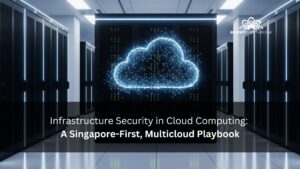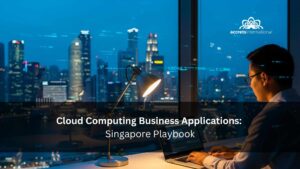Cloud storage keeps data safe and available while cloud computing runs applications and processing on that data. If you need backup, archive or file sharing, start with storage. If you need to run apps, analytics or AI, you need compute. Most projects in Singapore ultimately use both. Read on together to the end for a decision flow, mini cost math, SG compliance pointers and reference architectures you can copy.
Table of Contents
ToggleTL;DR
- Cloud storage is where your data lives. Think files, objects, backups, archives and data lakes. Its job is durability, availability and sharing.
- Cloud computing is where work happens. Think servers, containers, serverless and GPUs that process data and run applications.
- Most real projects use both. Data sits in storage. Compute wakes up to transform, analyze, serve or train on it.
- Quick guide: for backup or sharing, choose storage. For apps, analytics or AI, choose compute. For analytics on stored data, use both.
If you are tracking national initiatives, the approach aligns with Singapore’s Government on Commercial Cloud where agencies adopt commercial clouds with central guardrails for security, monitoring and auditability. Over 70 percent of eligible government systems are already on GCC. (tech.gov.sg)
A simple decision flow you can follow today
- Keep data safe and compliant for years: start with object storage and enable lifecycle policies to move infrequently accessed content into cooler tiers automatically.
- Run software or jobs: choose compute. Use virtual machines or containers for steady workloads, serverless for spiky or short tasks, and GPUs for AI inference or training.
- Query data already in storage: keep raw data in object storage and query it using serverless SQL or Spark rather than moving everything into a database first.
- Singapore tip: deploy in ap-southeast-1 or ap-southeast-2 when possible to reduce latency and avoid unplanned cross-region data transfer. If you serve users in China or Indonesia, plan for edge and cross-border connectivity early, for example by evaluating options like enterprise connectivity and a specialized route such as Teridion cross-border connection for China.
For broader context on why this shift is accelerating, you can see how Singapore’s public sector has been pushing secure modernization in its government digital transformation initiatives, and how the public sector leverages GCC in Singapore to balance agility with governance. (tech.gov.sg)
The side-by-side differences at a glance
| Dimension | Cloud Storage | Cloud Computing |
| Primary job | Persist and serve data reliably | Run code, applications, analytics and AI |
| Core resource | Capacity measured in GB, TB or PB | Processing measured in vCPU, RAM or GPU |
| Typical services | Object, file, block, backup, archive | VMs, containers, serverless, batch or ML |
| Common workloads | Backups, archives, media assets, data lakes | App hosting, ETL and ELT, BI or ML, VDI |
| Pricing baseline | Capacity, operations and egress | Time, invocations and data transfer |
| Security focus | IAM on buckets or shares, encryption at rest and in transit | Harden images, network segmentation, secrets and key rotation |
| Residency and latency | Choose SG region for PDPA and performance | Place compute near data and users to limit costly transfer |
If you expect a hybrid footprint, shortlist providers and patterns in our guide to hybrid cloud providers in Singapore and review what private cloud hosting looks like in 2025 so you can keep sensitive or latency-critical workloads close to users while retaining elasticity.
Scenario matrix you can copy
- Backup and long-term retention for PDPA or audits: start with storage using object storage, versioning, immutability and lifecycle policies. Add compute only for integrity checks and recovery testing.
- Business analytics on log, CSV or Parquet data: choose both using object storage as a data lake and serverless SQL or Spark for queries and transforms.
- Media streaming or asset delivery: lean on storage for origin and caching layers. Use compute for transcodes and packaging.
- AI inference near your data: use both where storage retains models and data while GPUs or serverless endpoints handle inference.
- VDI or steady app hosting: choose compute for persistent services and attach durable volumes. Use storage for profiles and backups.
- Disaster recovery and business continuity: pair storage for immutable backups and cross-region copies with compute for drills and actual failover. If you need help operationalizing, review cloud computing service providers in Singapore for backup and disaster recovery.
If your footprint spans Singapore and China, network planning is as important as the architecture. Teams often combine a robust backbone with enterprise connectivity and optimized routes like Teridion cross-border connection for China to maintain performance while meeting compliance obligations.
Pricing mini-math you can adapt
Prices change and differ by provider and region. Treat the following as mental models so you can ballpark directionally correct decisions.
1) Cold archive plus occasional query
- Storage: 50 TB in object storage with lifecycle to cooler tiers
- Compute: monthly ad-hoc query that scans around 2 TB from object storage
- Heuristic: if queries are sporadic, paying per TB scanned via serverless analytics is often cheaper than keeping an analytics VM running full time
2) Steady analytics job
- Storage: 10 TB lake with a 1 TB warm working set
- Compute: nightly 2 hour transforms
- Heuristic: if jobs run daily, a small reserved or spot compute cluster can beat purely on-demand serverless over a month
3) Media egress reality check
- Storage is inexpensive per GB, but your bill moves when content leaves the region
- Heuristic: optimize edge caching and compression. For certain use cases, a Singapore cloud VPS field guide can inform when to place hot assets closer to audiences for both speed and cost
For ongoing cost hygiene and guardrails, many firms lean on infrastructure IT outsource services in Singapore to instrument budgets, rightsizing and policy-based lifecycle automatically.
Security and compliance in Singapore
Shared responsibility differs subtly between storage and compute
- Storage: enforce bucket and object policies, encrypt at rest using KMS or HSM, enable versioning and immutability where appropriate, apply tight IAM on keys, confirm data residency
- Compute: harden images, patch OS and runtimes, segregate networks, manage secrets, rotate keys, and log access comprehensively
Local frameworks to keep in view
- PDPA governs the collection, use and disclosure of personal data and requires principles such as consent, purpose limitation, notification and retention controls. Architect storage and compute to uphold these obligations. (PDPC)
- MAS TRM for financial institutions sets expectations for governance, availability, incident response, cyber resilience and third-party risk. Map encryption, identity, monitoring and DR testing to these controls and conduct TVRA where needed. (Monetary Authority of Singapore)
- GCC for public agencies provides a secure wrapper to adopt commercial clouds with monitoring, auditability and residency guardrails. Government reports indicate strong adoption across eligible systems. (tech.gov.sg)
When designing controls and key management, practitioners find it useful to review patterns from our regional write-ups on cloud security consulting in Southeast Asia, the public-sector overview of GCC in Singapore and the financial services lens in cloud banking solutions for Singapore and Southeast Asia.
Performance realities you should plan for
- Keep compute near data. Running analytics in one region against data in another can look harmless until inter-region transfer charges and latency appear in dashboards
- Avoid chatty cross-AZ designs unless you truly need multi-AZ. High throughput ETL or microservices with many small calls can multiply cross-AZ charges
- Edge and cross-border. If your users or data sources are in China, Indonesia or the Philippines, design for connectivity from day one. Options like enterprise connectivity and Teridion cross-border connection for China can stabilize throughput while meeting compliance
- For sensitive or latency-critical workloads, combining a trimmed enterprise cloud computing stack with an on-premise private cloud can reduce jitter and help with residency
If your team is light on SRE capacity, structured business IT support in Singapore keeps these guardrails intact as your environment evolves.
Four reference architectures you can use
1) Storage-only with lifecycle policies
Use object storage for backups and archives. Enable versioning and immutability to improve ransomware resistance. Enforce legal holds and retention where needed and auto-tier to cooler storage for older data. Add minimal compute for periodic integrity scans and restores. If you are weighing platform choices, compare the advantages of IaaS and the difference between PaaS and IaaS so your ops model matches the team you have.
2) Compute-centric app hosting
Choose VMs or containers for steady services such as APIs, VDI or line-of-business applications. Attach persistent volumes and back up to object storage. Scale horizontally with autoscaling groups. Keep configuration as code and consider expert help through IT implementation services if you need a secure landing zone and pipelines set up quickly.
3) Decoupled storage plus serverless compute for analytics
Land raw data in object storage and query via serverless SQL or spin transient Spark jobs. Only materialize aggregates that deliver value. This pattern often gives the best price to performance for ad-hoc insights without keeping clusters warm. If you are planning wider interoperability, review our primer on inter-cloud services interoperability.
4) Hybrid burst with on-prem and cloud
Retain sensitive systems on-prem or in a private cloud and burst to public cloud for peaks. Synchronize to object storage for DR. Use IT-DR as a Service and managed backup services to simplify drills. A cloud service broker helps orchestrate multi-provider choices while giving you one pane of control for governance.
Real-world examples that make the difference tangible
- Grab. Grab’s engineering leaders have written about leveraging AWS to scale services and data platforms across Southeast Asia. This illustrates the decoupled design in practice where storage retains data and assets and compute scales dynamically across microservices and analytics. (Grab Tech)
- Netflix. Netflix’s case study highlights how public cloud lets the company deploy thousands of servers and terabytes of storage quickly, combining object storage for media and data with elastic compute for transcoding, personalization and delivery logic. (Amazon Web Services, Inc.)
These examples show why modern platforms seldom treat storage and compute as either or. Instead they pair durable storage as the source of truth with elastic compute that lights up exactly when needed.
Thinking about next steps in Singapore
If you want a Singapore-specific assessment of your workloads that includes PDPA and MAS TRM checkpoints, cost modelling and a practical architecture recommendation, you can fill the form for a free consultation with an Accrets Cloud Expert for cloud computing vs cloud storage. We will review your current estate and provide a concrete action plan.
Where Accrets fits after you decide
Many clients ask us to stay involved to operationalize the chosen pattern in a pragmatic way
- For resilient run-ops and governance, see managed cloud service provider and managed IT services, and share our solution brochures with stakeholders
- If you need a platform foundation, we help with cloud infrastructure as a service, enterprise cloud computing or an on-premise private cloud
- For resilience, teams rely on managed backup services and IT-DR as a Service
- For workforce and applications, we can accelerate enterprise applications, enterprise email and Office 365, online collaboration tools and SAP Business One
Because facilities still matter for certain workloads, we will also advise when Tier 3 or Tier 4 data center characteristics are material to your design and SLAs. For portfolio planning and governance, compare models in our pieces on managed vs cloud services and AI governance in 2025 and why partnering with a managed cloud services provider matters.
Dandy Pradana is an Digital Marketer and tech enthusiast focused on driving digital growth through smart infrastructure and automation. Aligned with Accrets’ mission, he bridges marketing strategy and cloud technology to help businesses scale securely and efficiently.




